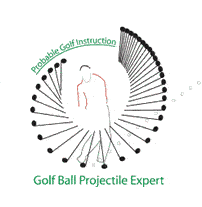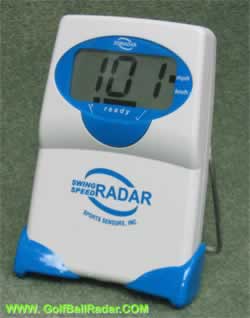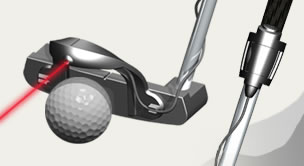
|
|
|
Golf Playing LessonsFrom this page, you can access playing lessons for various parts of the game. Click on the topics below and you'll be taken to the appropriate place in the website. Look below the navigation menu (the one below this sentence) for the specific page's content.
The Middle 3 Holes -- StrategyClick here to order Dave's Pelz's Short Game Bible, OR get it at your local bookstore. BUT, whatever you do, GET IT !! Your game will love you for it. Recap from Last Time † My statistical analysis of 1700 amateur scores found that 90% of players that play over NET PAR on the first three holes also shot over NET PAR for the total score. 82% of those that scored on the first 3 holes with a pace of NET 75 or worse, shot a total score of over NET 75 (assuming a 72 par). The first 3 holes of a round have a strong influence over the play for the rest of the round. As I've said many times, play conservatively on the first 3 holes to avoid disasters that will throw your confidence into a spiral. Holes 4, 5 and 6 Off the tee I'll hit a driver. If I hit it well, the ball will get to the bottom of a large swell and be within reach of the green on my second. If I miss my drive, I'll end up with a downhill lie in which case I'll just lay up with a 5-iron. Shorter hitters will remain short of the downhill and have a fairly level lie for their second. Many make the mistake of hitting a wood off the fairway on the second and end up in the trees either left or right, followed by a large number. This is definitely a hole on which to be careful.. So, I hit my driver and miss it a little, so, I end up half way down the hill. If I were to really nail a fairway wood, I could get close to the green. However, because of the downhill lie, hitting a good shot is not that likely, thus I choose to hit a 5-iron which will put me to about the 120 yard mark. Because Salmon Arm is a very hilly golf course, the golfer experiences many uneven lies. It's important that one take enough club and swing while focused on being very balanced; no swinging hard here. As is often the case for me on downhill lies, I hit the shot a little thin. Off a downhill lie, the ball flies lower and to the right than normal and thus runs further, so, even though I didn't make solid contact, I end up at the 120 yard mark. I always aim a little left of my target (5-10 yards) to compensate for the tendency for the shot to start out to the right. I hit my full pitching wedge 110 yards and my full 9-iron about 130 yards, so there is a definite gap. Instead of having a club for 120 yards, I just choke down about an inch on my 9-iron. The lie this time is a little uphill, which one tends to pull. The flag is on the right hand side of the green which is guarded by the bunker. To go at the pin, I'd need to aim at the bunker. If the shot doesn't pull, I'd be in the bunker, so, I aim at the pin expecting to end up 15 - 25 feet left; and, that's what happens. So, it's not a long par 5 thus one might expect a birdie. However, it has many difficulties (that's why it's handicap #1) and given I missed my drive and the pin is on one side of the green, it's not a hole on which to get aggressive. The putt I'm left is slightly downhill because the green slopes left to right. I'm happy to lag my 20 footer up close and take my par. I'm 2 over par after four holes and feel good that I've played smart so far giving me a sense of confidence. Hole #5 is a pretty little par 3 of about 140 yards. The tee is about 5 yards above the green which means it plays about 135 yards. The green is tiered so that there are 3 difference regions, none of which are flat; It's about 40 yards wide, with one tier of the right and two on the left. One can get some wild putts on this hole. The green is also guarded by water on the front, left and bunkers back left and right left. The pin is cut short and right, one of the easier placements. If I were to aim at the pin and pull it, I could end up on the lower, left tier leaving me a very long, difficult putt. If I land the ball a little right of the right, it will kick left. A well struck 9-iron will put me on the front, or front-middle of the green. A choked down 8-iron would put me in the middle or middle-back, leaving me a downhill putt. I'd rather hit the 9, and if I mis-hit a bit and call short leaving a fairly simple chip. I aim 5 - 10 yards right of the pin and make good, solid contact. The ball ends up on the right hand fringe and is puttable. I have left an 18 footer that is slightly downhill and bends left. I plumb the putt and determine the putt will break about 6 inches. Because it is slightly downhill, the putt will generally break a little more, so I allow for 7 inches. I put a good stoke on the ball, and make the putt. Finally, a birdie, and better yet, a DEUCE. Patience does pay off. You just don't want to try forcing things, especially if you're not hitting the ball well. Hole #6 is a straight, 340 yard par 4. The fairway is about 10 yards above the tee and the green; you hit up and then hopefully down. The key is not to hit it too far. Ideally, I hit my trusty 2-wood to about the 100 - 110 yard mark leaving myself close to a full wedge. If I hit it further, I'll be left with a fairly severe downhill lie and about 70 yards; a really tough partial wedge. I could hit driver well and get it to the bottom of the hill and have a 30-40 yard wedge shot left, but that's not the percentage shot to play. On this hole, the wind has come up. It's behind me a slightly across from left to right. I measure the wind speed to be about 2 metres per second, but because the tee is below the fairway and is shelterd by trees, the speed must be greater than that measured. A ball hit with the wind will run farther, so I decide to hit a 2-iron so I don't end up with that horrible downhill lie for my second. The 2-iron will also fly lower and not be as affected by the wind. I aim down the middle of the fairway expected the ball might drift a little to the right. There is OB (out of bounds) down the left hand side I don't want to flirt with. I'm left with 120 yards for my second from the right hand side of the fairway. The pin is cut front-left and is guarded by a front bunker. Now that I'm on the raised fairway, I can definitely feel the strength of the wind and I measure wind speed to be 3 metres per second. With that wind speed and the fact that the green is 6 yards below the fairway, the shot will play about 100 yards. For me, that's a full wedge while choking an inch down on the grip. The ball will drift to the right with the wind. If the ball gets up high into the air, the wind will carry it farther. I'd rather be longer than short in the bunker. Plus, if I pull my wedge, I could miss the green into a bunker on the left. So, I decide to aim 5 yards right of the flag and accept I'll probably be a little long. I hit a solid wedge, pull it a touch and the wind drifts the ball to the right. The ball ends up 5 yards right of the pin and about 25 feet long. The putt is lightly down hill and breaks slightly left to right due to the ridge that separates the left and right tiers of the green. The putt will be a little fast and thus lagging is the only thing on my mind except I don't want to be short and leave myself a downhill 2nd putt. I'd rather be 4 feet long than 3 feet short. If I'm long, I'll see how the putt breaks as it goes past the hole and uphill putts are easier to sink because they don't break as much. I hit a good putt with good speed and actually leave myself a tap in. After 6 holes, I'm one over par and feeling confident in the way I am managing my game, even though I don't have my ball striking A game. There's many facets of confidence in golf. The major one, in my opinion, is feeling in control. I feel in control because I have been making careful, conscious decisions on how to play shots to avoid trouble. In my next newsletter, we'll finish the nine holes and talk more about playing in the wind.
If you have any questions or comments, feel free to email me at golfexpert@probablegolfinstruction.com ©Probable Golf Instruction, Ken Tannar 2001-2011. All Rights Reserved. Langley, B.C. V2Y 2G4Phone: 604-539-7760 FAX: to fax, email an attachment probablegolf@yahoo.ca or golfexpert@probablegolfinstruction.com |
| GOLF SOFTWARE |
|
Power Meter measures Swing Speed
|
| GOLF NEWS |
|
| GOLF NEWSLETTER |
Statistics
·Putting
·Long Balls
·Games
·Handicap
·Scoring
·Shot Patterns
·Tournaments
·Tours
Pro Shop
·Ball Marker Engraved
·Books
·CDs & DVDs
·Green Reader
·Impact Labels
·Laser Rangefinder
·Longer Drives
·Products
·Teaching Aids
|
Subscribe to the Probable Golf Newsletter
and
|
| GOLF POLL |
The 19th Hole
·Advertising
·Ask the Golf Expert
·Consultation/Litigation
·FAQs
·Golf Blog
·Golf Draws
·Links
·Science of Golf
·Tell a Friend
·Testimonials
·

Golf Ball Finder Glasses
·
| GOLF CARTOON |







